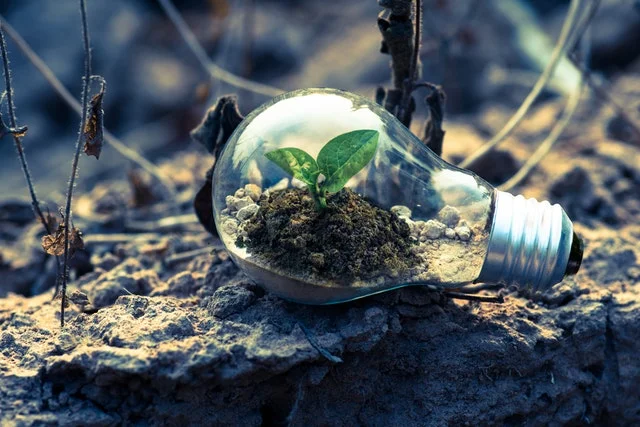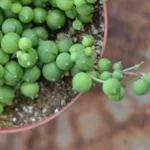Table of Contents
Your Guide to Chinese Money Plant Soil
The secret to a healthy Chinese money plant is good soil. Read on for top tips on the right soil for your plant!
What Soil is Best for a Chinese Money Plant?
The most important point to remember is drainage. Chinese money plants don’t like to get their feet soggy in waterlogged soil, so you must ensure good drainage and fast-drying compost. Wet soil can cause the roots to rot and the plant will die.
You will have success with potting compost mixes meant for cacti. In the shops, you will find brands for cactus and succulents.
These are ideal for your Chinese money plant and will ensure good drainage and they will not retain moisture.
These kinds of mixes contain peat, perlite, sand, and limestone. You can buy them in garden centers or online.
Alternatively, if you want to make your own mix you could add perlite or pumice to a compost mixture. Sphagnum peat moss is the base for most general potting soil mixtures.
You can start with this and then add some limestone to balance its pH and provide more nutrients for your Chinese money plant.
Next, you need to add perlite or pumice to make sure your mix drains well. Perlite is a kind of volcanic rock that expands when you heat it.
It looks like little foam balls. Adding perlite is essential for free-draining soil.
Pumice is also a volcanic rock that is excellent for drainage. As it is heavier than perlite it doesn’t rise to the top of the pot when you water your plant. You might prefer pumice for a better look for your soil.
You need 4 parts soil to 1 part perlite. Experiment with different amounts and see what suits your plant best.
What Soil Do Chinese Money Plants Like?
You will need free-draining soil for your Chinese money plant. Buy a potting compost mix that does not retain moisture. Look for brands that are meant for a cactus and you will be on the right track.
Make sure your mix contains perlite or pumice. Loamy soil is also good.
Chinese Money plants will tolerate poor soil but they will thrive best in peaty soil with a good amount of nutrients.
Experiment with different combinations of soil types until you find the perfect mix.
Before you use your compost mix make sure it is not infested with fungus gnats or other soil pests.
Take a careful look at your soil and if there are pests there you will need to treat the mixture or just buy a new bag.
How Do You Take Care of a Chinese Money Plant in Soil?
Chinese Money Plants are easy to care for. Follow these top tips for a healthy plant:
- Choose a container with drainage holes that is ceramic, clay, or plastic
- Water once a week if necessary but only when the soil is very dry
- Place in medium, indirect sunlight
- Choose a potting compost mix that is suitable for cactus and succulents
- Propagate by cutting the plantlets from the mother plant with a knife
- Repot once a year with fresh compost
- Fertilize your plant every 2 or 3 months in the growing season
- Rotate it once a week so it doesn’t get lop-sided
Can You Use Cactus Soil for a Chinese Money plant?
Many garden centers and shops sell potting compost mixes that are labeled suitable for a cactus or a succulent. These are ideal for your Chinese Money plant. Chinese Money Plants don’t like to live in wet soil.
Commercial compost mixes for cacti will contain peat, seramis, sand, and grit. This free-draining mixture is ideal for your money plant. Also, you can make your own if you prefer.
How Do You Repot a Chinese Money Plant?
Chinese money plants are slow-growing so you don’t need to repot them often. Once a year should be sufficient.
It is best to repot in the growing season so that is spring or summer. The plant will recover well and go on to thrive in its new pot.
You need to repot your plant so that it does not get root-bound. When the roots are too tightly packed together the plant will start to wilt and yellow. The roots need room to grow.
Repotting also gives you a chance to refresh the soil. Old soil becomes compacted and loses its nutrients. You can introduce fresh compost as part of the repotting process so your plant can continue to do well.
Firstly, water your plant a few days before the repotting. Choose a new pot one or two inches larger than the old pot. Make sure the new pot has a drainage hole.
Fill the new pot with your potting compost mix and gently slide the old plant out of its pot by holding it upside down. Trim the root ball.
Place it in the new pot about an inch below the surface and fill the pot up with compost. Pat the surface down with your fingers. Water your plant thoroughly.
What Kind of Container is Best for a Chinese Money Plant?
Terracotta pots are best for Chinese money plants. They are the top choice because they are porous and allow the roots of your plants to breathe.
They stop waterlogging of the soil. Any excess moisture will be absorbed into the pot so you will avoid the problem of rotting roots that can kill your plant.
Follow these tips I have given you and you can enjoy your beautiful Chinese Money Plant for many years to come!
Where Should I Put my Chinese Money Plant?
Chinese Money Plants prefer a medium amount of light. They do well near an East or alternatively a West-facing window.
If your window gets the sun in the early morning then it is East-facing. This kind of window light is the best for your plant. If your window catches the light in the afternoon or evening, then it is West-facing.
This kind of window light can become too hot at times so it’s second-best for your money plant.
Avoid North and South-facing windows as there is not enough light or too much.
Your plant will thrive in filtered light that mimics the dappled light coming to the forest floor through trees. Consider a net curtain or a slatted blind for your window to achieve this effect.
All About Chinese Money Plants
Native to China
The Chinese Money Plant (Pilea Peperomioides) is a popular houseplant that grows easily in the right soil. It is native to the Yunnan and Sichuan regions of China.
In its native land, it grows on rocks in forests at high altitudes. Sadly, it is now rare in the wild, but it’s grown all over the world as an ornamental plant.
Missionaries returning home in the 1900s to Norway and Britain introduced the plant to Europe.
Common names
It is sometimes known as the pancake plant, UFO plant, coin plant, friendship plant, and pass-it-on plant. It grew popular by being shared among friends as it still is today.
Nettle
The money plant is part of the nettle family and sometimes has small white flowers in summer. It grows to about 30 cm (12 ins). The large leaves can be about 15 cm (6 ins) across.
Leaves
The plant has bright green leaves that are shaped like pancakes. This kind of green means they look fantastic against white walls, providing a burst of colour.
It’s an elegant choice for a table or windowsill that will draw the eye and attract praise from your visitors.
Buy online
These plants can be hard to find in shops, so you may have to beg one from a friend. Failing that, look online for sellers if you can’t find one in your local garden center.
No-toxic
Chinese money plants are non-toxic so they are safe for your pets and your baby. Sometimes animals chew plants but this one will do your furry friends no harm. The same is true for your children so you have no worries for your family’s safety.
Easy
The plant is easy to grow and simple to propagate, so you can share it with your mates and family. Just give it indirect sunlight near a window in your home or office.
Water it when it’s dry and give it fertilizer every few months in the growing season. This plant couldn’t be easier to look after!
Chinese Money Plants love:
- Light watering
- Medium sunlight
- Feeding
Image by hosPhoto by Singkham from Pexels



